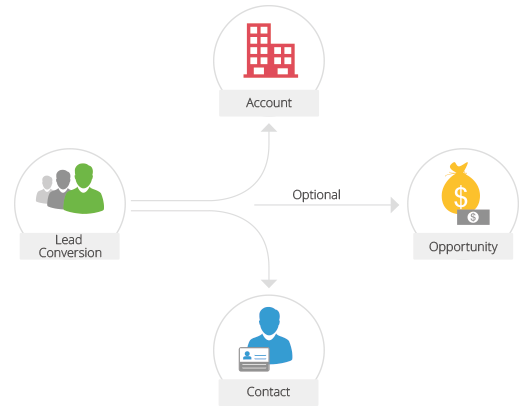When there is a chance for further negotiations with a lead, it can be converted into an account, contact, and finally a deal. In short, once the lead status has reached a certain stage, it can be qualified as a deal. On conversion, a lead is converted to an account and contact and then, if appropriate, a deal can be created upon conversion. You can map the lead fields with those of the account, contact, and deals so that the details are transferred to the appropriate fields. See Also Map Fields
Note
- A lead cannot be reverted once converted to contact or account.
- An account will be created on lead conversion if the Company Name detail is available for the lead.
- During conversion, if the record owner chooses to merge the lead with an existing account or contact, and if he has read only permission for account/contact (module or record) then though lead will be converted and merged, the fields in the account or contact records will not be updated.
Permission Required
Users with the Convert Leads permission in profile can access this feature.
When converting a lead to a deal, first a new account and contact are created with the relevant lead data, and then a new deal is created. The following table provides descriptions of various fields converted to an account, contact, and deal during lead conversion. If you have custom fields, you can map them too. See Also Map Fields
To convert leads to other sales records
- Click the Leads tab.
- In the Leads Home page, select the lead to be converted.
- In the Lead Details page, click Convert.
-
In the Lead Conversion page, choose the appropriate account/contact option.
-
The options to create an account/contact or add to the existing account/contact will be available based on different use cases. (Refer to the table)
-
Select
Create a new Deal for this Account/Contact checkbox if you want to create a deal on lead conversion.
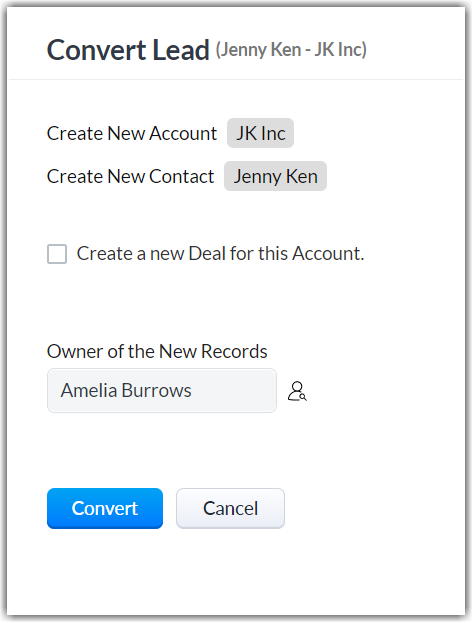
All the mandatory fields for the Deals module will be listed.
Specify the Deal Name.
By default, the Company Name will be populated as the deal name.
- Specify the Deal Closing Date or select the date from the calendar displayed.
- Select the Deal Stage from the drop-down list.
- Select the Contact Role from the drop-down list.
- Enter the Amount.
-
Choose the Campaign Source from the lookup.
-
Select the Owner of the record.
-
This option will be available only if a new record is created.

- Click Convert.
Note
- All the mandatory fields available for the Deals module will be listed during lead conversion. An exception to this is when you have created page layouts. If you have created multiple page layouts, upon conversion of leads via workflow or mass convert, you will see only the mandatory fields of Deals - Deals Name, Closing Date and Stage.
- When the Email Address Duplication Check is enabled, you will not be able to convert a lead, if the following conditions are true.
- Lead is assigned to a User A and User B tries to convert it.
- User B is a subordinate to User A in the organization's hierarchy.
- There are duplicates available for the record.
- During lead conversion, the values from Leads module to Contacts module will be transferred only if the fields in the contact module are empty.
During conversion either a new record is created or it is merged with an existing record. The system finds out similar accounts or contacts using the below method:
- Unique fields: If a contact or an account has unique fields such as phone number, SSN, website etc. then during lead conversion the system will first find out similar accounts or contacts using values present in these fields.
For example, in the below image a similar record was identified using the contact's phone number.
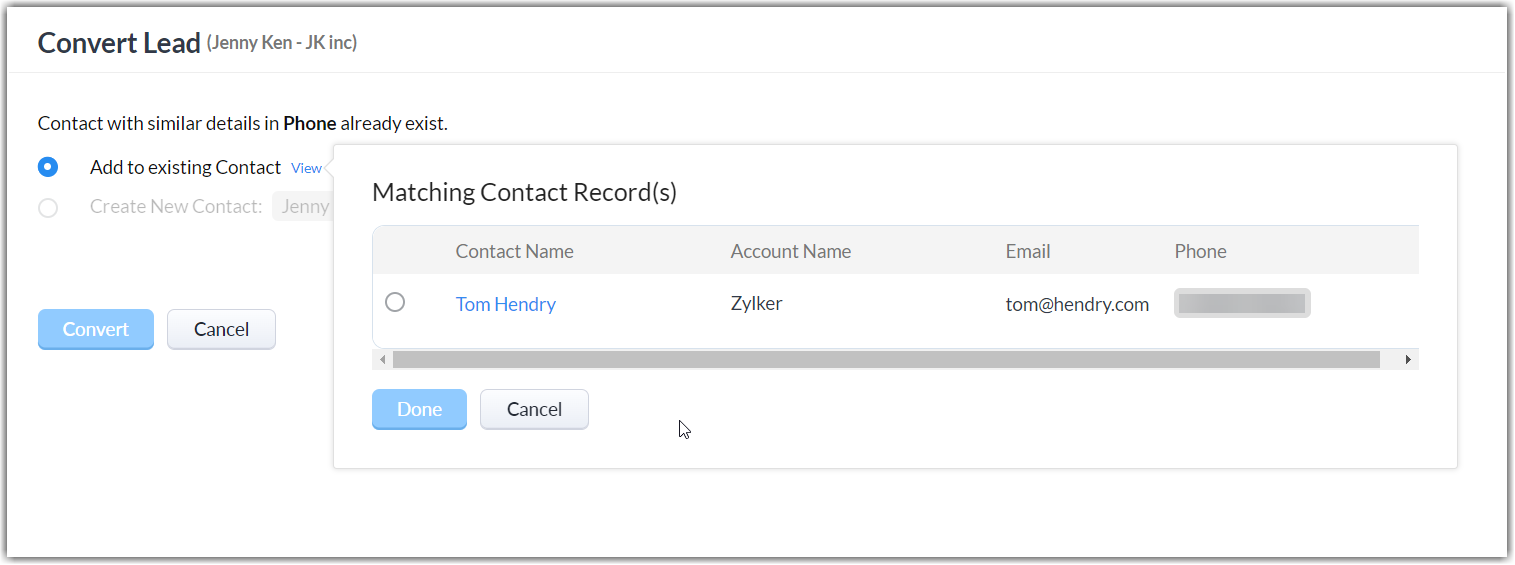
- System defined fields: If similar records are not found using the unique fields then following system-defined fields in the Leads module will be used to find similar records: Leads email address, Leads company name, and Lead name. If a similar record is found the user can merge them.
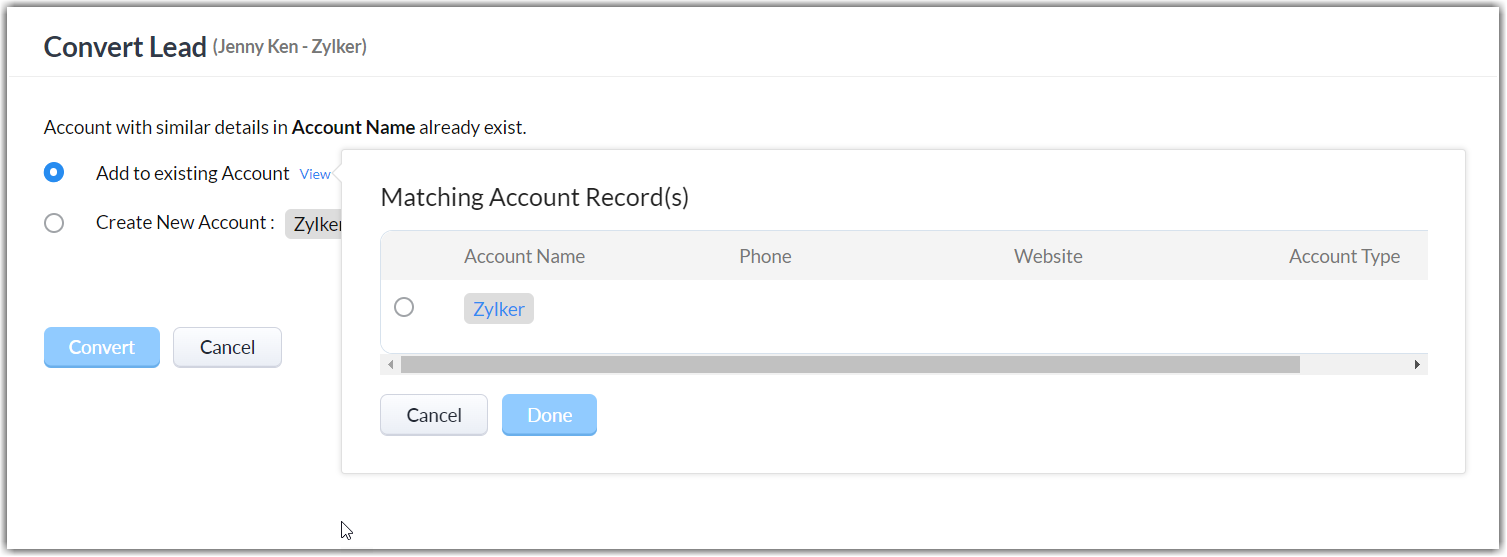
Note: Unique fields are given priority over system defined fields while checking for similar records.
Using Unique Fields
Assume we have the following unique fields in the contacts and accounts modules respectively, now based on whether a value is available or not available for these fields the system will either ask to create a new record or merge with existing record.
The table below gives a detailed scenario:
- Contact module - SSN value
- Accounts module - LinkedIn ID
|
Scenario
|
If the Account or Contact exists
|
If the Account or Contact doesn't exist
|
|
Available:
SSN
LinkedIn ID
|
- If the contact with same SSN is present, then following option will be present: Add to existing contact.
- If that contact doesn't have any Account associated with it then the Linkedin ID will be used to search for similar Accounts. If matching Account is found following option will be present: Add to existing Account.
|
- Search will happen using the Lead's email address, or lead's company name or Lead name.
- Lead name will be checked only when the lead's email and company name fields are empty.
|
|
|
Available: SSN
Unavailable: LinkedIn ID
|
- If the contact with same SSN is present, then following option will be present: Add to existing contact.
-
If this contact doesn't have Account associated with it, then system will perform the following actions:
1. Search Accounts with Leads's company name:
If similar accounts are found then you will have the option to Add to existing Account.
2. If no account is found in Step 1. then you will have an option to Create New Account and associate it with the contact.
Note: If there are no unique fields in Accounts, new account creation will be the only available option.
|
- Search will happen using the Lead's email address, lead's company name or Lead name.
- Lead name will be checked only when the lead's email and company name fields are empty.
|
Unavailable: SSN
Available: LinkedIn ID
|
- If the Account with the same Linkedin ID is present, then the following option will be present: Add to existing account.
- The system will perform the following actions for Contact:
-
Search the contacts associated with the above account using the Lead's email address or Lead name. If a match is found then you will have the option to Add to Existing contact.
-
If no matching contact is found then you will have an option to Create New contact and associate it with the Account.
Note: If there are no unique fields in the Contacts module, new contact creation will be the only available option.
|
- Search will happen using the Lead's email address, or lead's company name or Lead name.
- Lead name will be checked only when the lead's email and company name fields are empty.
|
Using system-defined fields
If unique fields are not present in the accounts or Contacts module then the system will search for similar records using the system defined fields in the Leads module. Let us take for example a lead with the following details:
Map Fields
When a lead is converted into an account, contact, and deal, the lead's field values are transferred to the mapped account, contact, and deal fields. Only when the fields are accurately mapped with those of the corresponding modules, will the data be transferred properly.
By default, the standard fields are mapped with the corresponding fields of the other modules (Accounts, Contacts, and Deals). With the lead conversion mapping tool, you can easily map other fields that you create. Please note that you need to map a field with a similar type of field as well as field length only. For example,
- A text field should be mapped only with a text field
- A picklist field should be mapped only with a similar type of picklist field.
- A single line field of 255 characters can be mapped only with another text field of 255 characters or greater.
To map lead fields with other modules
- Go to Setup > Customization > Modules and Fields.
- From the List of modules, select the Leads module.
- Click the Module Settings icon > Lead Conversion Mapping.
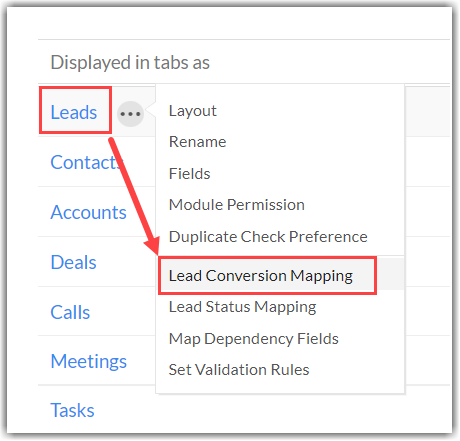
- In the Map Fields for Leads Conversion page, the fields are listed under the Lead Fields column. Fields under corresponding modules (Accounts, Contacts and Deals) are also present.
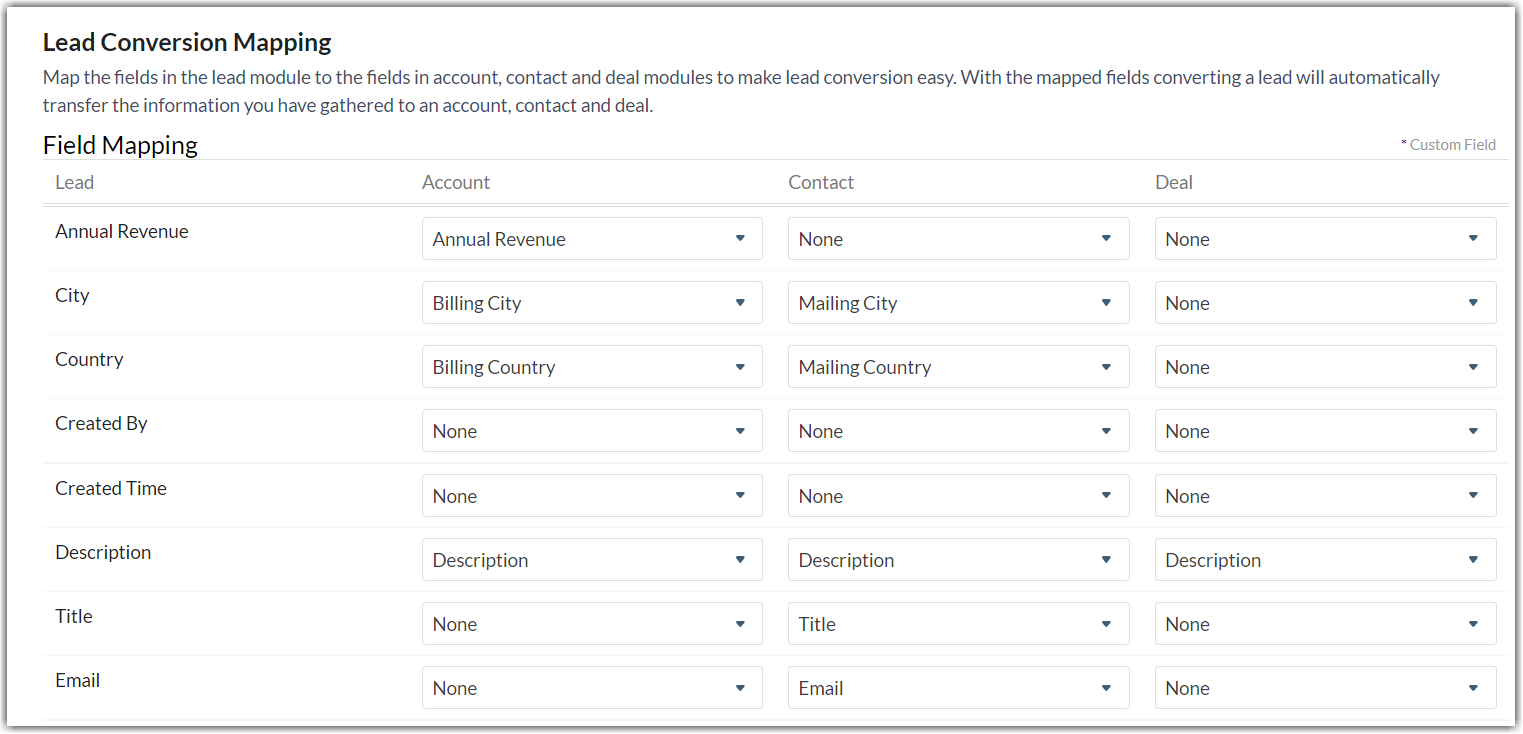
- Map the lead fields to the corresponding fields of Accounts, Contacts and Deals.
- Click Save.
Note
During lead conversion, if you choose to create a deal, the notes added to the lead will automatically be moved to the corresponding deal. A copy of the notes will also be shown in the relevant account and contact. If you do not create a deal during lead conversion, then the notes will be available only in the corresponding contact.
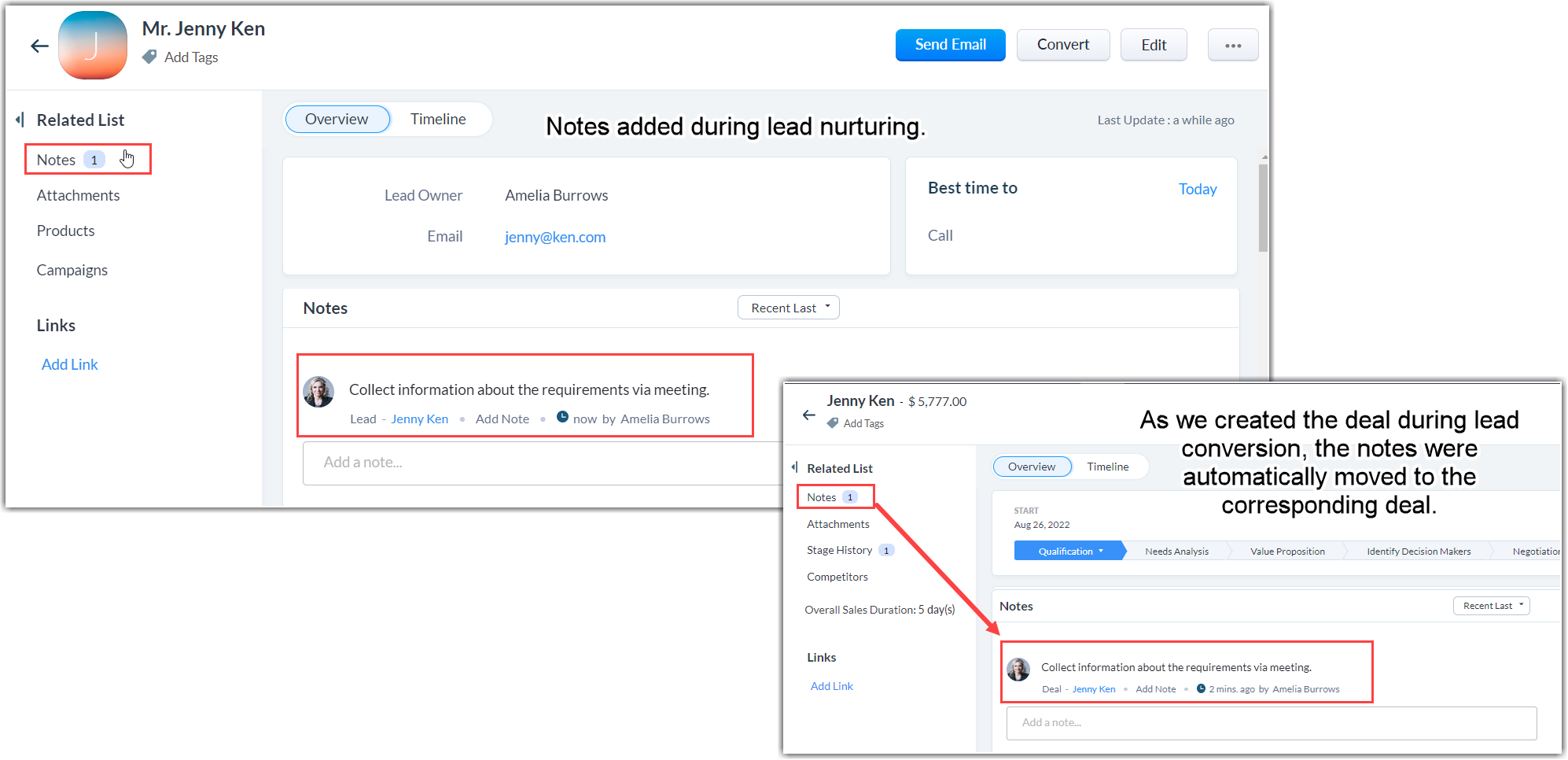
- When converting a lead, you have the choice of selecting where to move the attachments. They can be moved either to Contact, Account or Deal. If a deal is not being created, then you can choose to move the attachments to Contact or Account.

Map fields based on page layouts
If you have created multiple layouts for a module, you can enable conversion of leads across layouts.
For this, you must map the fields of one layout with the corresponding layouts of another module. For example, you have created a layout called Mobile Service in the Leads module, all the fields from the Mobile Service layout in Leads can be mapped with the Mobile Service layouts of Contacts, Accounts and Deals as per your requirements.
To map fields based on page layouts
- Go to Setup > Customization > Modules and Fields.
- From the List of modules, select the Leads module.
- Click the Module Settings icon > Lead Conversion Mapping.
-
In the Map Fields for Leads Conversion page, choose the desired layout under the Leads module.
-
By default, the fields of the Standard layout of Leads, Contacts, Accounts and Deals are displayed
- Choose the corresponding layout under Contacts/Accounts/Deals as required.
For each field under Leads, map the corresponding field under Contacts/Accounts/Deals from the dropdown lists.
- Click Save.
Note
- By default, the fields from Leads are mapped to the Standard layout of other modules.
- Upon account downgrade, layout based conversion will not happen as the layouts will no longer exist. However, immediately after downgrade the mapping settings will remain intact until you edit the settings.
- When you attempt to deactivate/delete a layout that has been associated in lead conversion mapping, you will be prompted to remove the layout from the mapping settings before you can deactivate/delete it.
- When page layouts have been enabled, if you select the Also Create for Contacts/Accounts/Deals checkbox while creating a custom field for Leads, the auto-mapping of custom fields will not take place.
- For every field under Leads, the corresponding fields under Accounts/Contacts/Deals will not be displayed in the dropdown list for mapping, if their field types and field length do not match.
During field mapping, the fields of a subform that are present in the Leads module can be mapped with the fields of a subform present in the Contacts, Accounts, or Deals module. The mapping can be done among fields with similar data type and field length.
For example,
- A number data type field can be mapped with another number data type field in the subform of other module.
- A lookup field can be mapped with a similar lookup field.
Note
- The fields can be mapped when leads are converted,
- One at a time
- Through API
- By workflow rules
- Field mapping will not be carried out when records are converted in bulk (Mass Convert).
To map subform fields with other modules
- In the Lead Conversion Mapping page, go to the Subform Field Mapping section. The subform and the list of fields will be displayed.
- In the first row, select a subform from the drop-down list.
All the subforms present in the Accounts, Contacts, and Deals modules will be listed.

- Map the fields with the suitable fields from the Accounts, Contacts, and Deals.
-
Click
Save.

Close Leads Without Converting
Based on your business requirements, you may want to close the leads instead of converting them. In such a case, you can do the following:
- Add a custom value (Closed) for the Lead Status field.
- Change the Lead Status to Closed.
- Create a List View to filter all the leads that are closed.
By default, some industry standard pick list values are available in the Lead Status field. You can modify the pick list values as per your organization's business process and replace the existing value with new value.
To add a pick list value
- Log in to Zoho CRM with Administrator privileges.
- Go to Setup > Customization > Modules.
- From the List of modules, select Leads.
- From the available Layouts, select the layout you want to change
- In the Lead Status pick list field, select the Field Settings icon and select Edit Properties.
- In the Pick List Properties popup, click the Add (+) icon beside a value to add a new value below it.

- In the Add New Value box, specify Closed.
- Click Done.
- Click Save Layout.
Convert Leads in Bulk
Mass conversion of leads is possible in the Leads module by selecting multiple records from the list view.
To convert selected leads in bulk
- Click the Leads tab.
- From the list of leads, select the ones that you want to convert.
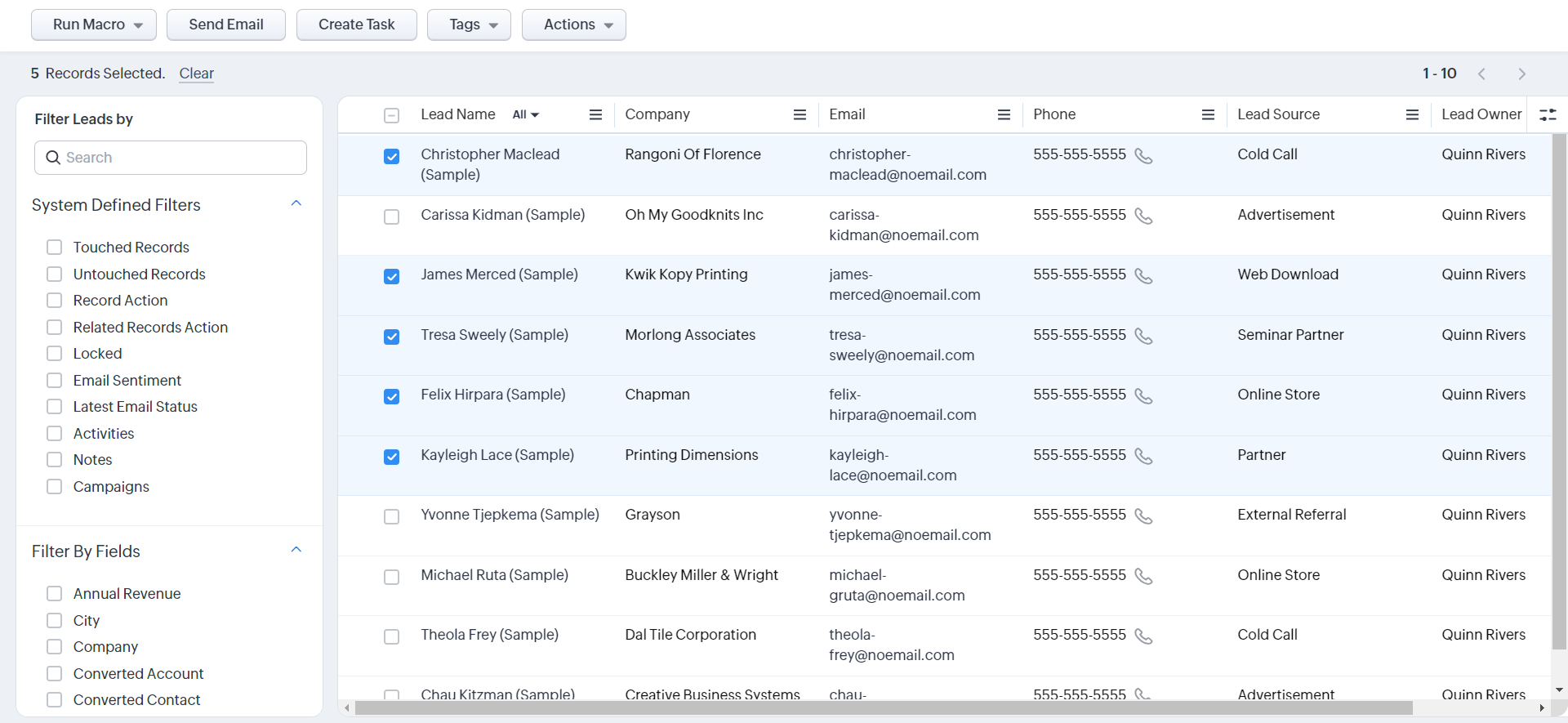
Click Actions > Mass Convert.
In the Mass Convert pop-up, do the following:
Select the Deal checkbox, if you want to create a deal upon lead conversion.
Fill the Deal Name field.
Click + to add other fields and fill in their details.
Choose where to move your attachments to. The lead record's attachments will be moved to this record post conversion (Contact, Account, or Deal).
-
Select the Owner of the New Records. By default, all the converted contacts, accounts, and deals will be assigned to the users who own the respective leads.
-
If you want, you can also move the tags to contacts, accounts, and deals.
-
Click Convert.
-
Choose where to move your attachments to.
-
Click the Change link to select one owner for the contacts, accounts or deals that the leads are being converted to. By default, all the converted contacts, accounts and deals will be assigned to the users who own the respective leads.
-
If you want you can also move the tags to other modules.
- Click Convert.
To filter records based on criteria and then convert them in bulk
In the Leads module, ensure that you haven't selected any record. Click Actions > Mass Convert.
- Enter the criteria for filtering leads.
- Click Search.
- Select the filtered records.
- Click Mass Convert.

Note
- Validation rules will not be checked during conversion.
- Any tags associated with the leads can be carried over to accounts, contacts, and deals upon individual as well as mass conversion of leads.
- If you decide to transfer tags to an account, but no new accounts are created or existing accounts cannot be found during the conversion process, the tags will be moved to the contact for those records.
Field-related details for Deals module
- During conversion, unfilled fields will be populated based on conversion mapping.
- Unique fields in the deals module will not be available during mass conversion.
- New deals will be added to default pipeline for each layout.
- If the chosen stage value is not in the default pipeline, the first stage will be used. Otherwise, the chosen stage will be applied.
- If the record currency field is chosen during mass conversion, all deals will be created in that currency. If not, the values in the currency fields will be considered as values in home currency and converted based on the lead record's currency and exchange rate in currency setup.
- Users can add and populate lookup fields in the mass conversion form. The values of configured fields of lookup depend on whether they are included in the form:
If included, they are populated based on the lookup field's selection.
If not included, values are applied according to lead conversion mapping.
Duplicate record check during conversion
- During conversion, if there is a possibility of duplication of records, then the lead details will be merged with existing records.
- The duplicates are checked in the following order:
1) Unique fields* in Contacts
2) Unique fields* in Accounts
3) Email field* in Contacts
4) Account name field in Accounts
5) Contact name** field in Contacts
* These fields will be checked only if they are mapped in conversion mapping.
** This check will occur only when the lead's email and company name fields are empty.
If the lead matches a contact
- If the contact is associated with an account, the contact's account will be not be changed.
- If the contact is not associated with an account and the lead's company field is filled, then
1. If the lead's company matches the name of an existing account, the contact will be linked with that account.
2. If the lead's company does not match the name of an existing account, a new account will be created, and the contact will be linked with that new account.
If the lead matches an account
- If the lead's email address matches the email address of a contact linked to that account, its details will be merged with that contact.
- If the lead's email address does not match the email address of any contact linked to that account, a new contact will be created and linked to that account.
SEE ALSO

